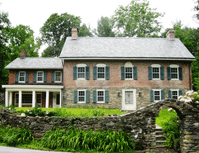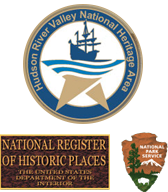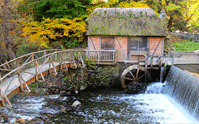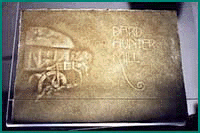



|
Dard Hunter - Owner from 1912 to 1918
William Joseph 'Dard' Hunter (1883-1966) was born in Steubenville Ohio, the son of William Henry- a newspaperman and editor- and Harriet Rosemond Hunter- a ceramics artist; Dard is a family nickname. Since his early youth, Dard helped his father in the family's printing shop. His early days were spent in an environment where intellectual activity mixed with the physical activity of printing and composing for a small town newspaper. From a young age, Hunter was familiar with the automatic type-setting machines at his father’s newspaper business and with mechanics of the modern papermill across the street from his home. Born into a family steeped in traditions of artistic creation, it was only natural for him to embrace the Arts and Crafts Movement renaissance that was taking place. At age 21, Dard enlisted with Elbert Hubbard to become a Roycrofter in East Aurora, NY and soon began designing book illustrations, stained glass windows, pottery, jewelry, and furniture. His designs and writings were popularized during his Roycroft period. Working in East Aurora, Dard met his future wife, Helen Edith Cornell, a Roycroft pianist; he also became enamored with researching the historic manufacture of paper. His inquires took the couple to Europe where he explored pre-historic and medieval papermaking techniques. On their honeymoon in 1908, they traveled to Vienna where Dard visited Weiner Werkstatt, the nucleus of Austria's Arts and Crafts movement. Dard applied to the Austrian Royal and Imperial Graphic Institute for Education and Research, but was denied admission because the school would only accept foreign students if they graduated from a state recognized educational institution. He returned to East Aurora determined to succeed. Dard forged the needed diploma from an imaginary U.S. accredited school on genuine parchment paper. He was convinced the fake document would work. Hunter left East Aurora for good in 1910, having successfully unified the Roycroft product line. This time, the Austrian school accepted him. He finished in 1911 with a certificate signed by the school's director. The Hunters then moved to London where they rented a home in Kensington, close to the great museums. London fascinated Dard and he spent his money in museums and bookstores until his money ran out and he was forced to take up work as a graphic artist. He spent his leisure time at T. J. Marshal & Co. and a lot of time at the London Science Museum and British Museum Library where he expanded his knowledge on papermaking. Financial straits made him look for a better paying job with Norfolk Studio on Fleet Street. In short order, he learned all he could about old fashioned papermaking. Returning to America, he decided that he would create a special place where he could research, write, and experiment with historic papermaking. The Hunters purchased the Gomez Mill House because its secluded enclave provided Dard with the perfect location. Due in large part to the Industrial Revolution, when Hunter moved to Marlborough, NY in September 1912 to focus on his work, there was absolutely no handmade paper being produced in America anymore. In a scenario eerily reminiscent of English colonial prohibitions during the U.S. revolution, early 20th century American artists and printers had to rely on Europe for handmade paper. Dard’s goal was to change this fact. In 1913, Hunter built a paper mill adjacent to the old gristmill pond and dam on Jew’s Creek across the road from the main house. The Mill, made from repurposed barn wood and bricks left over from the House, was fashioned after 17th century Devonshire cottages, complete with thatched roof made from rye he grew himself. Not wanting to compromise his goal to manufacture paper using 17th century techniques, Dard relied entirely upon a water wheel to generate power for the paper pulper in the Mill. Dard produced some of his most significant works here. He macerated linen rag to make the finest quality paper, and quickly became adept in papermaking and watermarking. His reputation spread fast through the Arts and Crafts Movement. The Chicago Society of Etchers commissioned Dard to create gifts for its members. Hunter made 250 copies of each book, written and illustrated by prominent artists. The Etching of Figures (1915) featured William Aspenwall Bradley (Author) and William Aurbach-Levy (Illustrator) while The Etching of Contemporary Life (1916) featured Frank Weitenkampf (Author) and Ernest D. Roth (Illustrator). Hunter's achievement was nothing short of monumentally historic. Until then all the world's handmade books were made by different masters in sequence- papermakers, typographers, printers- working separately with apprentices. Dard's creations were the world's first handmade books designed and constructed by one person. And his success inspired other Americans to begin producing handmade paper again. Well after Hunter left the Gomez site in 1918, he wrote his autobiography My Life With Paper where he documents his activities at the Marlborough paper mill and beyond. His time in Chillicothe, Ohio and at MIT are significant. He also traveled the world to catalog the history of papermaking. His works are highly valued. Dard was a phenomenon in American graphic arts. His stained glass lamps are remarkable, and his typography inspired Frederic Goudy to move to Marlboro in 1924. Goudy almost purchased the Gomez Mill House, but opted for a home further downstream. Much of today's enthusiasm for the Arts and Crafts Movement in America is linked to Dard Hunter. He was largely responsible for establishing what many feel was a graphic arts renaissance by applying 17th C. production methods to developing book arts. And he is credited with resurrecting handmade papermaking in the United States. For his lasting impact on graphic arts, he continues to be revered. Related: 'Papermaking — An Art for All Ages'
|
Home | About Us | Gallery G | Events | Donations | Membership | Visitors | Volunteers | Press | Contact Us | Directions | Privacy





